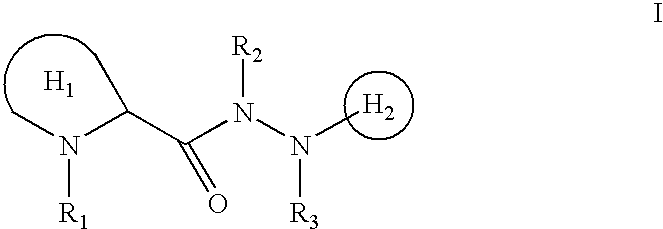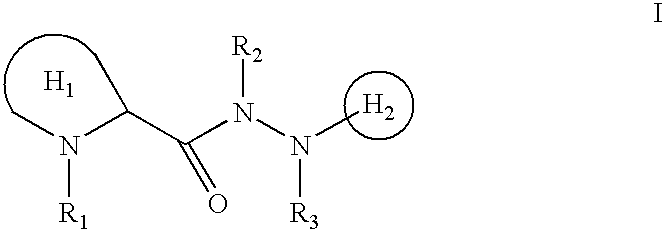N-heterocyclyl hydrazides as neurotrophic agents
a technology of n-heterocyclyl hydrazide and neurotrophic activity, which is applied in the direction of biocide, drug composition, metabolic disorder, etc., can solve the problems of somatosensory nervous system, somatosensory nervous system also constitute a class of debilitating and potentially lethal conditions, and neurodegenerative diseases constitute a major threat to public health
- Summary
- Abstract
- Description
- Claims
- Application Information
AI Technical Summary
Benefits of technology
Problems solved by technology
Method used
Image
Examples
example 1
Compound (1)
1-(3,3-Dimethyl-2-oxo-pentanoyl)-pyrrolidine-2-carboxylic acid N′-pyridine-2-yl-hydrazide
[0065]A mixture of (2S)-1-(1,2-dioxo-3,3-dimethylpentyl)-2-pyrrolidine-carboxylic acid (482 mg, 2 mmol), prepared from L-proline methyl ester according to the procedure described in WO 96 / 40633, 2-hydrazinopyridine (364 mg, 2 mmol), PyBrop (932 mg, 2 mmol), DMAP (4-dimethyaminopyridine, 122 mg) and DIEA (4 mL) in THF (dry, 50 mL) was stirred at room temperature for 24 h. Water and ethyl acetate were added. The organic phase was washed with ammonium chloride solution, followed by brine, and dried with MgSO4. Column chromatography (silica gel, ethyl acetate:methanol=10:0.5) gave a colorless oil; 490 mg (74%); MS (m / z) 333 (M+1); 1H NMR (d6-DMSO) δ0.85 (t, J=8 Hz, 3 H), 1.21 (s, 3 H), 1.23 (s, 3 H), 1.7 (m, 2 H), 1.90 (m, 1 H), 2.10 (m, 2 H), 2.35 (m, 1 H), 3.49 (t, J=8 Hz, 2 H), 4.62 (m, 1 H), 6.76 (m, 2 H), 7.51 (t, J=6 Hz, 1 H), 8.14 (d, J=6 Hz, 1 H).
[0066]Compounds (2)–(8) were synt...
example 2
Compound (9)
1-(2-Oxo-2-thiophen-2-yl-acetyl)piperidine-2-carboxylic acid N′-(6-methyl-4-trifluoromethyl-pyridin-2-yl)-hydrazide
Intermediate 1: Methyl 1-(1,2-Dioxo-2-methoxy)-2-piperidinecarboxylate
[0067]A solution of methyl pipecolinate hydrochloride (7.2 g, 40 mmol) in dry DCM (100 mL) and TEA (8.3 g) was cooled to 0° C. The slurry was stirred for 1 h. Methyl oxalyl chloride was added. The mixture was stirred at 0° C. for 2 h. Water was added, and the organic phase was washed with a NaHCO3 solution, dried with MaSO4. Evaporation of the solvent and drying in vacuum gave a reddish oil; 9.1 g (99%); MS (m / z) 252 (M+Na).
Intermediate 2: Methyl 1-[1,2-Dioxo-2-(thien-2-yl)ethyl)-2-piperidinecarboxylate
[0068]To a solution of Intermediate 1 (2.29 g, 10 mmol) in THF at −78° C., a solution of thienyllithium (1.0 M, 13 ml, 13 mmol) was added slowly. The mixture was stirred at the same temperature for 4 h, quenched with ammonium chloride solution, extracted with ethyl acetate, and dried with Mg...
example 3
Compound (10)
2-Azetidinecarboxylic acid, 1-[(phenylmethyl)sulfonyl]-, 2-(2-pyridinyl)hydrazide, (2S)-
[0071]
1-Phenylmethanesulfonyl-azetidine-2-carboxylic acid methyl ester:
[0072]Azetidine-2-carboxylic acid (560 mg, 5.5 mmoles) was suspended in methanol (25 mL) and cooled to −5° C. under an argon atmosphere. Thionyl chloride was added dropwise and the mixture was allowed to warm to room temperature over a 3 hour period. After concentration in vacuo, the residue was dissolved in dry dichloromethane (25 mL) and treated sequentially with benxzyl sulfonyl chloride (1.17 g, 6.14 mmoles) and diisopropylethylamine (2.15 mL, 12.3 mmoles). After stirring overnight, the mixture was concentrated and purified by flash chromatography on silica gel to afford 1.13 g (76%) of the product as a colorless oil. 1H NMR (CDCl3) δ2.29–2.51 (m, 2H); 3.21–3.29 (m, 1H); 3.81 (s, 3H); 4.02 (q, 1H, J=8.6); 4.32 (d, 1H, J=14.6); 4.46 (d, 1 H, J=14.6); 4.86 (dd, 1H, 9.4, 8.6); 7.34–7.43 (m, 3H); 7.46–7.54 (m, 2H)...
PUM
| Property | Measurement | Unit |
|---|---|---|
| Power | aaaaa | aaaaa |
| Electrical conductance | aaaaa | aaaaa |
| Electrical conductance | aaaaa | aaaaa |
Abstract
Description
Claims
Application Information
 Login to View More
Login to View More - R&D
- Intellectual Property
- Life Sciences
- Materials
- Tech Scout
- Unparalleled Data Quality
- Higher Quality Content
- 60% Fewer Hallucinations
Browse by: Latest US Patents, China's latest patents, Technical Efficacy Thesaurus, Application Domain, Technology Topic, Popular Technical Reports.
© 2025 PatSnap. All rights reserved.Legal|Privacy policy|Modern Slavery Act Transparency Statement|Sitemap|About US| Contact US: help@patsnap.com



